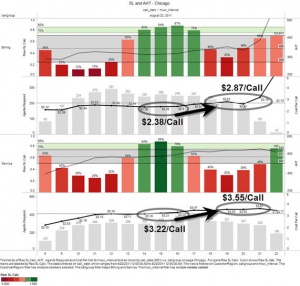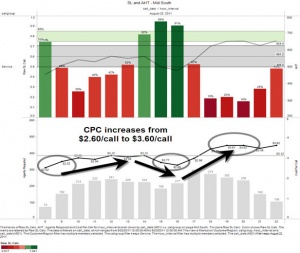Cost Per Call Exceeds Cost To Maintain Service Level
Contents
[hide]Introduction
Contact centers are highly dynamic work environments — with constant fluctuations in workload on a monthly, weekly, daily and hourly basis; thus, nothing of a static nature typically works well in the contact center. This is particularly true of staffing and scheduling. Most centers, then, use a variety of staffing strategies to ensure that the center has the right number of people in the right place at the right times. Not only does a mix of staffing approaches help to meet the needs of the center and the customers, it often adds diversity to agents’ jobs and makes the challenging position more palatable, which helps to increase engagement and ensure that agents are actually at their desks when they are expected to be.
When contact centers fail to recognize this or do not have the ability to staff correctly to ensure service level is consistently met, the impact to the business can be significantly more expensive, outweighing any dollars potentially saved by not having the staff in place.
One specific cause for a workforce management's inability to staff to consistently meet service level is not having sufficient staff schedule options to properly fit the call demand curve. Organizations which run a high percentage of Traditional “Fixed Full-Time” agents often have times throughout the day in which they are understaffed, and usually have an overlap period in which over staffing occurs. This has a customer and financial impact to the business:
- Staffing to average call load causes variation in SL delivery to customers
- Staffing to peak call load causes waste in over-capacity during average or below average load
- Intraday and day of week failures translate into repeat calls, poor experience
- Long cycles of short staffing incur expensive training up of unplanned resources (cycle which repeats through seasons/events)
In addition, as demonstrated by the examples below, not maintaining service level throughout the day also directly impacts agents' productivity, which can result in a greater cost to the business than if staffing levels were maintained to meet service level.
Example 1
Productivity Impacts
- As Service Level deteriorates, AHT extends 30 to 60+ seconds across all calls.
- Typical queues require only 5 to 10 additional agents to recover severe SL deterioration
Financial Impact Example
- Increase in AHT drives your effective Cost Per Call up by 15 to 20%, with extreme examples increasing up to 40%+.
- Addition staffing required to close service level gaps: ~3% on queues >=300 agents, 6-7% on queues <100
- Increased Service Level Cost: 1600 calls/Hour * $0.30 / call = $480 premium cost per interval.
- Staff required to maintain lower AHT = 8 agents, or ~$180 cost per interval.
- Cost to business is > 2.7x to allow Service Level to run below target.
Example 2
Productivity Impacts
- As Service Level deteriorates, AHT extends 30 to 60+ seconds across all calls.
- Typical queues require only 5 to 10 additional agents to recover severe SL deterioration
Financial Impact Example
- Increase in AHT drives your effective Cost Per Call up by 15 to 20%, with extreme examples increasing up to 40%+.
- Addition staffing required to close service level gaps: ~3% on queues >=300 agents, 6-7% on queues <100
- Increased Service Level Cost: 1600 calls/Hour * $1.00 / call = $1600 premium cost per interval.
- Staff required to maintain lower AHT = 10 agents, or ~$200 cost per interval.
- Cost to business is > 8x to allow Service Level to run below target.


